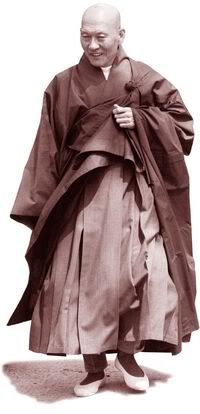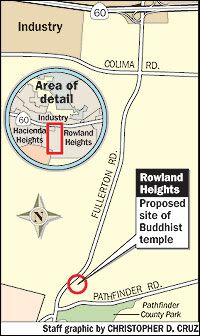Hãy tìm Đức Phật trong gia đình ta.
18 tháng 4, năm 2005. KST
 Chùa chiền không phải là nơi duy nhất mà chúng ta tìm thấy Đức Phật, mà là ở nhà, trong gia đình. Vị sư đức hạnh người Đại hàn Pubjeong đã nói “ Bởi vì đối những gia đình tan nát, ngôi nhà chỉ là cái vỏ lạnh giá, ông nói hôm chủ nhật vừa qua. "Đừng tìm Đức Phật hay Bồ Tát nơi chùa chiền, chúng ta phải suy nghĩ thông suốt, phải chất vấn thật kỹ trái tim nình, và đem tình thương đó sưởi ấm mái nhà mình".
Chùa chiền không phải là nơi duy nhất mà chúng ta tìm thấy Đức Phật, mà là ở nhà, trong gia đình. Vị sư đức hạnh người Đại hàn Pubjeong đã nói “ Bởi vì đối những gia đình tan nát, ngôi nhà chỉ là cái vỏ lạnh giá, ông nói hôm chủ nhật vừa qua. "Đừng tìm Đức Phật hay Bồ Tát nơi chùa chiền, chúng ta phải suy nghĩ thông suốt, phải chất vấn thật kỹ trái tim nình, và đem tình thương đó sưởi ấm mái nhà mình".Nhà sư đã nhấn mạnh điểm này trong buổi thuyết giảng Phật pháp thường lệ vào mùa xuân tại chùa Gilsang ở Seoul’s Seongbuk-dong, đã thu hút hơn 1500 tu sĩ và Phật tử.
Nhà sư kể một câu chuyện, “ Một người đàn ông dọn đến ở với con trai mình sau khi vợ ông chết. Một ngày nọ, tình cờ ông nhặt được quyển sổ ghi chép chi phí trong gia đình, trong đó có đoạn ghi rằng tiêu phí 20 đô cho người đần độn.” Người đàn ông hiểu người đần độn là ám chỉ mình và lập tức rời nhà. Nhà sư nói “ Một gia đình không có tình thương chẳng khác nào con người chúng ta chỉ có thân mà không có tâm”. Ông cho rằng sự đổ vỡ của gia đình là do lòng ích kỷ và chủ nghĩa cá nhân được xem quá trọng.
Ngày nay chúng ta không ra sinh ra ở trong nhà, chúng ta đón mừng sinh nhật lần thứ nhất, thứ mười, thứ 60, 70, và luôn cả cái chết cũng chưa hẳn là xảy ra trong nhà. Những trường hợp như vậy, chúng ta hãy nhìn lại một cách nghiêm túc, ý nghĩa của mái ấm gia đình là gì.
Nhà sư nhấn mạnh, nhìn lại trái tim mình một cách kỹ lưỡng là điều vô cùng cần thiết khi chúng ta muốn hiểu tại sao có sự đổ vỡ trong gia đình. “ Ngày nay, vợ chồng rất dễ ly dị, nhưng nếu chúng ta không chuyển được nghiệp thì dù có ly dị, chúng ta vẫn không tháo gỡ được những gút mắc xáo trộn.
“ Bởi thế gian đen tối, dơ bẩn, tham muốn, và đầy đau khổ.” ông nói thêm cho dù mục đích có khác nhau đi nữa, những gì ta có trong tim rất quan trọng, cuộc sống chúng ta tùy thuộc vào sự lựa chọn phương cách để giải quyết những trỏ ngại. Nếu chúng ta xem gia đình và láng giềng như một phần của chính mình, và sống với trái tim mình nhiều hơn trong từng giây phút, thì thay vì ta nói “ Ông chồng đáng ghét của tôi đang đến,” ta có thể nói, “ Đức Phật đang đến.” Ta có thể sưởi ấm mái nhà bằng tình thương nơi trái tim ta, và ta sẽ cảm nhận đây mới là hạnh phúc.
Nhà sư kết thúc buổi diễn thuyết : "Tìm hiểu con tim mình là điều vô cùng cần thiết. Thay vì ta có thể nói tiêu phí 20 đô cho người đần độn, ta nói 20 đô tiêu phí cho đức Phật".
Khánh văn lược dịch
Find Buddha in the Family, Revered Monk Urges
Updated Apr.18,2005 14:32 KST
It is not in the temples that we must look for the Buddha, says the revered monk Pubjeong. It is in the home, in the family. “Because of broken homes, there are many cold houses that are just shells, while the warmth of families has disappeared," he said Sunday. "Don’t look for the Buddha or bodhisattvas in temples. We must gather our thoughts and through studying our hearts bring them inside ourselves and into our families.”
He made the remarks during his regular spring dharma talk at Gilsang Temple in Seoul’s Seongbuk-dong, which drew some 1,500 Buddhist to a scene resplendent with the colors azaleas, forsythias and cherry blossoms.
The monk picked a telling example. “A 70-year-old grandfather moved in with his son after his wife died. One day, he went into his son and daughter-in-law’s room and by chance caught a glimpse of the housekeeping book. In it he read the words, ‘Spending money for the country bumpkin ? W20,000 (US$20).’” The father recognized that the bumpkin was him and left the house forthwith, Pubjeong said. “A family without warmth is like a body without a soul," he said. He attributed family breakup to a growing tendency to selfishness and egoism. “These days, we’re born outside the home, and we mark our first, sixtieth and seventieth birthdays and even deaths outside our homes. In such circumstance we need seriously to look back at what the home and family are to us.”
Pubjeong stressed that study of our own hearts is needed when we want to understand the breakup of the family. “It’s easy to get divorced these days, but if we cannot correct our karma, even if we divorce, we cannot untie the tangled knot," he said, quoting Buddhist teachings. “Because the world is darkness, filth, want and pain, regardless of our personal intention, what we have in our hearts is important, and how our lives are depends on how we resolve to live.” He said if we think of our families and neighbors as our reflections, "and correct our hearts moment to moment so that we think, ‘The Buddha has come’ rather than ‘The husband I hate has come,’ we can change our cold homes in ones full of joy and thankfulness.”
Pubjeong ended his talk with a quip. “We must study our hearts so that in the future, instead of ‘spending money for the country bumpkin - W20,000.’ we can write ‘spending money for the Buddha ? W200,000.'"
(Kim Han-su, hansu@chosun.com )
http://feeds.bignewsnetwork.com/redir.php?jid=ea55a3cdaccf683b&cat=f97ff7b11934dbb6
 LOS ANGELES- Sau một cuộc tranh chấp dai dẳng giữa hai nhóm chống đối nhau, Hội Ðồng Kế Họach Khu Vực hôm thứ tư đã phê chuẩn khu đất tám mẫu dành kiến tạo một ngôi chùa tại Rowland Heights. Một thành viên của trung tâm nói rằng "Tôi thích chí lắm, anh có thể tin không ? Chúng tôi đã chờ đợi bảy năm"
LOS ANGELES- Sau một cuộc tranh chấp dai dẳng giữa hai nhóm chống đối nhau, Hội Ðồng Kế Họach Khu Vực hôm thứ tư đã phê chuẩn khu đất tám mẫu dành kiến tạo một ngôi chùa tại Rowland Heights. Một thành viên của trung tâm nói rằng "Tôi thích chí lắm, anh có thể tin không ? Chúng tôi đã chờ đợi bảy năm" Nằm trong những địa điểm được ưa chuộng đối với du khách ngoại quốc là những tự viện Phật Giáo. Phong cảnh, không khí thiên nhiên đông phương và sự phong phú của nghệ phẩm văn hóa luôn là điều thú vị thu hút du khách. Tuy nhiên, một trở ngại lớn lao là thông tin về những ngôi tự viện bằng Anh Ngữ đã hầu như không còn tồn tại cho đến bây giờ.
Nằm trong những địa điểm được ưa chuộng đối với du khách ngoại quốc là những tự viện Phật Giáo. Phong cảnh, không khí thiên nhiên đông phương và sự phong phú của nghệ phẩm văn hóa luôn là điều thú vị thu hút du khách. Tuy nhiên, một trở ngại lớn lao là thông tin về những ngôi tự viện bằng Anh Ngữ đã hầu như không còn tồn tại cho đến bây giờ.